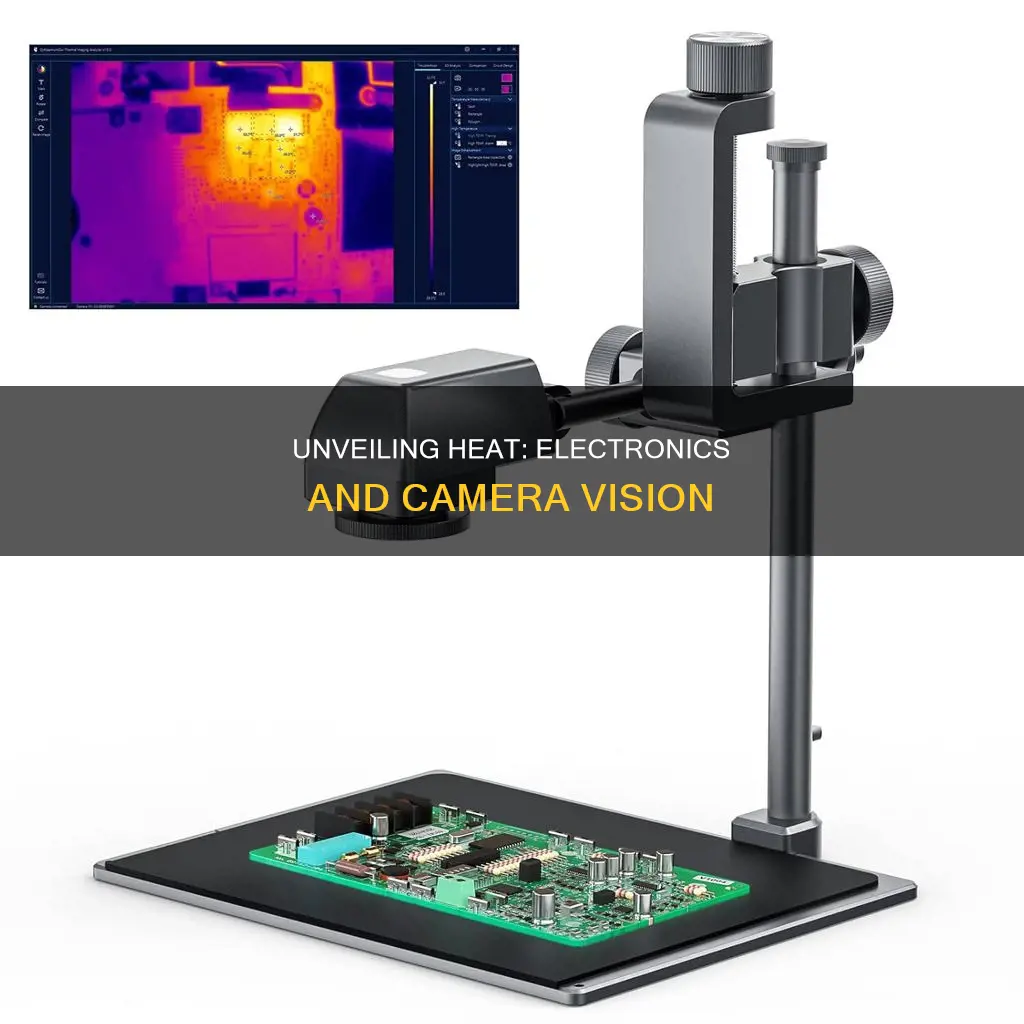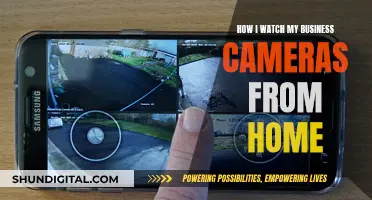
Thermal imaging cameras are an effective way to see heat on electronics. These cameras use infrared light to detect and measure the heat signatures emitted by objects. This technology is particularly useful for identifying heat sources or areas of excess temperature, such as in electronics. By converting infrared waves into images, thermal cameras can visualise temperature differences and help users pinpoint potential failures or problems in electronic systems. This non-contact method is safe, efficient, and easy to use, making it ideal for electronics design, testing, troubleshooting, and repair.
| Characteristics | Values |
|---|---|
| Purpose | Identify temperature differences in electrical circuits, detect faults, and identify heat sources |
| Technology | Non-contact, converts infrared waves into images, detects infrared light |
| Ease of Use | Easy, rapid diagnosis and measurement without shutting down equipment |
| Safety | Measures temperature from a distance, ideal for dangerous environments |
| Display | Colour or greyscale, with warmer areas shown in yellow, orange, and red, and cooler areas in blue and purple |
| Use Cases | Building inspections, overheating components, wildlife spotting, firefighting, plumbing, HVAC, electronics, security |
What You'll Learn
- Thermal imaging cameras can be used to identify heat sources or areas of excess temperature
- They can be used to inspect a building for possible gaps in thermal insulation
- They can help locate survivors during firefighting, disaster response, and nighttime police pursuits
- They can be used to identify where heat is being lost from a property
- They can be used to identify faults or electrical shorts when electronic systems fail

Thermal imaging cameras can be used to identify heat sources or areas of excess temperature
Thermal imaging cameras are an effective way to identify heat sources or areas of excess temperature. They are equipped with heat sensors and a special lens that can be used with standard image-capture technology. These cameras can detect infrared light, which is part of the electromagnetic spectrum that is invisible to the human eye. By using thermal imaging cameras, engineers can quickly identify heat sources or areas with higher temperatures.
Thermal imaging cameras work by detecting and measuring the infrared radiation emitted by objects, which is known as heat signatures. The infrared frequencies are passed through a lens that focuses them onto an array of sensors for detection and reading. These sensors consist of pixels that convert infrared wavelengths into electronic signals, which are then transmitted to a processor inside the camera. The processor uses algorithms to convert these signals into a colour map that displays various temperature values. This allows users to identify areas of higher temperature, which can indicate potential failures in equipment or systems.
Thermal imaging cameras are particularly useful in situations where physical contact with an object would alter its temperature and skew the results. They are also valuable in areas where equipment cannot be shut down or easily accessed. For example, in the building and construction industry, thermal imaging cameras can be used to detect heat loss and identify faulty insulation, leaks, and gaps. In industrial settings, they can help identify equipment overheating, uneven heat distribution, and system inefficiencies.
Overall, thermal imaging cameras are a valuable tool for identifying heat sources and areas of excess temperature, providing users with data and insights that can improve efficiency, prevent equipment failures, and optimise processes.
Viewing Wyze Cameras on PC: A Simple Guide
You may want to see also

They can be used to inspect a building for possible gaps in thermal insulation
Thermal imaging cameras can be used to inspect buildings for possible gaps in thermal insulation. They can identify areas of heat loss, which can indicate poor insulation or gaps in windows. Inspectors can use these cameras to check for things like heat loss or air leakages, helping to determine whether insulation is needed and where it should go.
Thermal imaging cameras work by detecting and measuring the infrared radiation emitted by objects, which is known as their heat signature. The camera's lens focuses infrared frequencies onto an array of sensors that detect and read them. These sensors consist of pixels that convert infrared wavelengths into electronic signals, which are then transmitted to a processor inside the camera that converts them into a colour map that depicts various temperature values. Warmer areas will be shown in reds, oranges, and yellows, while cooler areas will appear in blues and purples.
When inspecting a building for gaps in thermal insulation, inspectors will typically perform an interior or exterior survey, depending on which method will yield the best results under the given weather conditions. Interior scans are generally more accurate due to reduced air movement, but exterior scans can also be useful, especially if there is a large temperature difference between the inside and outside of the building.
By using a thermal imaging camera to inspect a building for gaps in thermal insulation, inspectors can identify areas of heat loss and determine whether additional insulation is needed. This can help improve the energy efficiency of the building and reduce heating costs.
Insignia TV: Camera-Equipped or Not?
You may want to see also

They can help locate survivors during firefighting, disaster response, and nighttime police pursuits
Thermal imaging cameras are a valuable tool in various emergency situations, including firefighting, disaster response, and nighttime police pursuits. They can play a crucial role in locating survivors and enhancing the effectiveness of rescue operations.
During a firefighting operation, thermal cameras enable firefighters to identify hidden hotspots within burning structures. This information is vital for preventing potential structural collapses and directing firefighting efforts efficiently. Additionally, these cameras allow firefighters to see through thick smoke, improving overall safety and helping them locate fellow team members in dangerous situations.
In disaster response scenarios, such as earthquakes, hurricanes, or floods, thermal imaging cameras are indispensable for rescue teams. They can detect the heat emitted by survivors trapped under rubble or stranded in flooded areas, guiding rescuers directly to their location. This technology increases the chances of survival for missing persons, as search teams can quickly pinpoint their heat signatures.
Thermal cameras are also valuable in nighttime police pursuits, aiding enforcement agencies in tracking suspects. They are particularly useful in low-visibility conditions, such as during the night or in densely populated areas. To further enhance the effectiveness of aerial support units during pursuits, a thermal ID film called Mirage has been developed. This thin-film, self-adhesive material is applied to the roofs of emergency service vehicles, allowing them to be easily identified through a thermal imager.
The advantages of thermal imaging technology extend to various environments, including urban areas, forests, bodies of water, and industrial settings. Their ability to "see" temperature variations in complete darkness, smoke-filled environments, or situations with poor visibility makes them a powerful tool for rescue and emergency response teams.
Are You Being Watched? Detect Hidden Cameras
You may want to see also

They can be used to identify where heat is being lost from a property
Thermal imaging cameras can be used to identify where heat is being lost from a property. These cameras can be attached to smartphones or used as standalone devices. They are particularly useful for identifying heat loss through windows, doors, and other exterior openings.
When using a thermal imaging camera to identify heat loss, it is important to ensure a temperature differential of at least 20 degrees between the inside and outside of the property. This will help the camera detect heat leaks more effectively.
When scanning for heat loss, it is recommended to scan both the interior and exterior of the building. Scanning the exterior of the building can help identify any warm air escaping from the building, especially from insulation leaks on the upper side of the structure due to air convection movements. Scanning the interior can help detect any streams of cold air coming in through openings on the lower side of the building.
Thermal imaging cameras can also be used to inspect pipes for leaks. Wet areas caused by leaking pipes will appear warmer than their surroundings on a thermal imaging camera, making it easier to identify the source of the leak.
By identifying areas of heat loss, homeowners can take steps to improve insulation and seal gaps, ultimately reducing energy consumption and lowering heating bills.
Cameras: Are They Really Watching You?
You may want to see also

They can be used to identify faults or electrical shorts when electronic systems fail
Thermal imaging cameras are an effective way to identify faults or electrical shorts when electronic systems fail. They are a non-contact technology that can detect and measure infrared radiation emitted by objects, which we perceive as heat. This technology is particularly useful for electronic systems as it allows for the identification of temperature differences compared to normal operating conditions.
Thermal imaging cameras can be used to identify electrical unbalance and insulation resistance breakdown, which can be caused by power delivery problems, low voltage, or an insulation breakdown inside motor windings. Abnormal heating associated with high resistance or excessive current flow is a common cause of problems in electrical systems, and thermal imaging allows us to see these invisible thermal signatures of impending damage before any damage occurs.
When using a thermal imaging camera to identify faults in electronic systems, it is important to take both visual and thermal images for side-by-side comparison. This allows for the identification of temperature differences and the detection of potential issues. It is also important to note that thermal imaging should be used in conjunction with other test technologies to determine the exact cause of the problem.
Thermal imaging cameras are a valuable tool for quickly identifying and troubleshooting electronic system failures. By using this technology, technicians can identify performance anomalies and target problem areas to accelerate troubleshooting and validate repairs.
It is important to follow safety precautions when working with electronic systems and to have the appropriate personal protective equipment (PPE) when working with energised electrical equipment.
Exploring Cameras in After Effects: A Beginner's Guide
You may want to see also
Frequently asked questions
A thermal imaging camera can detect heat on electronics. These cameras are equipped with special lenses and heat sensors that allow users to observe the infrared spectrum, which is otherwise invisible.
Thermal imaging cameras convert infrared waves into images that represent temperature differences within a range of colours.
Thermal imaging cameras have many applications, including building inspections, electronics testing, wildlife tracking, and search and rescue operations.
When choosing a thermal imaging camera, consider factors such as resolution, sensitivity, temperature range, ruggedness, connectivity options, and whether it has both thermal and optical imaging capabilities.
Yes, thermal imaging cameras do not work well through glass or underwater due to the way infrared wavelengths interact with these mediums. They are also less effective during daylight hours when objects absorb heat from the sun.







